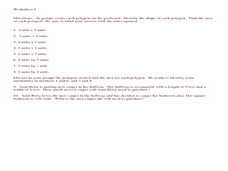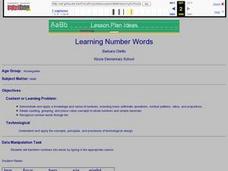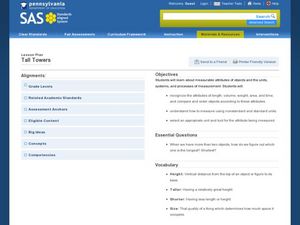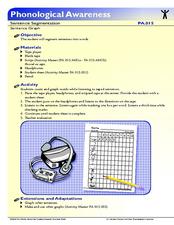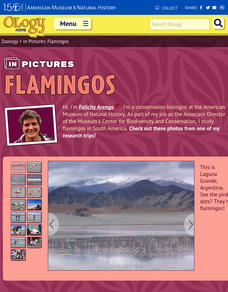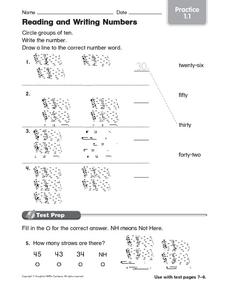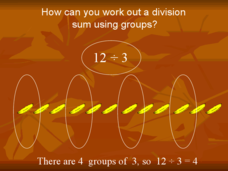Curated OER
How Many Units?
Young mathematicians calculate the area of rectangles and squares. For this geometry lesson, learners are grouped in pairs and use geoboards to construct rectangles. They calculate the area of the figure by counting the number of square...
Curated OER
Six
Challenge your beginning counters with this worksheet focused on the number 6. Four sets have fewer than 6 objects in them. Learners count how many are pictured, and draw more to make 6. They write the numeral 6 in a box for each set...
Curated OER
Narrow it Down: Numbers
Elementary learners of all ages utilize their number knowledge by playing a 20 questions style game. They participate in a game in which they ask yes or no questions to a group leader in order to discover which number the leader has...
Curated OER
Add Tens
Learners solve six story problems about adding 10s. Provide 10-rods or objects they can group into 10s to visualize what is being asked. Two of the problems provide irrelevant information; with discussion and guidance, this is also a...
Curated OER
Food Pyramid Abacus
Students investigate the Food Pyramid by constructing a creative project known as a Food Pyramid Abacus. They correlate the color beads withe each food group and the number of recommended servings from each. The abacus is a learning tool...
Curated OER
Valentine Heart Candy
Each student gets a box of candy Valentine hearts. The students open the box and count how many of each colored heart they have in their box. The students use this information to make a bar graph and answer follow-up questions.
Curated OER
Learning Number Words
Students practice saying their numbers and identifying the words. They use whole numbers and decimals to practice grouping numbers into different categories. They write the word of the number they are shown.
Curated OER
Making Math More Fun
Trick young mathematicians into practicing their basic arithmetic with this extensive collection of fun math games. Whether you're teaching addition, subtraction, multiplication, division, place value, or even fractions, there is a...
K5 Learning
Mixed Practice Word Problems #6
Nine questions make up a mixed practice worksheet. The word problems require scholars to show what they know about money, addition, subtraction, multiplication, and division using numbers up to 5,300.
K5 Learning
Mixed Practice Word Problems #3
Seven word problems make up this mixed practice instructional activity. Learners perform operations of addition and subtraction to solve problems using numbers up to 2,800.
Computer Science Unplugged
Count the Dots – Binary Numbers
Did you know you can send a message using only zeroes and ones? This interactive resource presents an introduction to binary numbers. Through code cards, pupils learn to convert binary numbers to decimal numbers.
Curated OER
Learning to Multiply
Learning how to multiply is the focus of this math resource. The first of five pages reviews the multiplication process as repeated addition. The second provides a few examples that you might consider working through with the class. An...
Curated OER
Tall Towers
Linear measurement is the focus of this math lesson. Youngsters work in groups to build towers with blocks. They build towers represented on index cards and determine how many blocks taller one tower is.
Florida Center for Reading Research
Phonological Awareness: Sentence Segmentation, Sentence Graph
Young scholars segment sentences while they listen to a series of sentences. Using a graph, pupils make a mark for each word they hear. Learners listen to each sentence three times; once to listen, once to mark, and once to check their...
American Museum of Natural History
Saving Species
Some scientists dedicate their lives to researching and protecting endangered species. An online lesson teaches about three scientists around the world who do just that. They learn about spiders, mollusks, and reptiles from North...
American Museum of Natural History
In Pictures: Flamingo
Fifteen photos take scholars on a journey to Laguna Grande, Argentina to observe how a group of scientists work with native flamingos. Stunning images showoff the flamingo, its environment, scientists in the wild, and the impact the...
Curated OER
Blast off with Guided Reading!
Introduce guided reading to your classroom with this space-themed PowerPoint. As you count down from ten, students are exposed to the purpose and practices of guided reading; until they are ready to blast off into their small groups....
Curated OER
Addition and Subtraction Word Problems Guided Lesson
Using visuals helps young mathematicians grasp concepts such as addition and subtraction. Here, they use just that to solve three scenarios. In the first scenario, three turtles leave a group of five, and learners determine how many...
Curated OER
Turkey Match
In this turkey match learning exercise, students match pictures of turkeys to the correct number of turkeys in the picture. Numbers range from one to five. This is a one-page learning exercise.
Curated OER
Mystery Jars: Make Your Own
Students explore the concept of estimation. In this estimation lesson, students create their own estimation jars and fill them with objects of their choice. Students then count the exact number of objects and trade jars to...
Curated OER
Ten in the Bed
First graders share the story "Ten in the Bed". They rewrite the story so that the initial character is calling others to bed. There was one in the bed and the little one said, "Come to bed, come to bed." There were two in the bed and...
Curated OER
Investigation-Pattern/Functions
Students explore number patterns. In this number patterns and probability math lesson, students work in groups to describe the patterns present in the first five rows of Pascal's Triangle, then write numbers to continue this pattern....
Curated OER
Reading and Writing Numbers: Practice
In this reading and writing numbers learning exercise, 1st graders circle groups of ten and write the total number on the line. Students then draw a line to its matching number word.
Curated OER
Dividing Using Groups
Three simple slides show the relationship between division and multiplication. Items are grouped into equal sets based on the division problem presented, then related to repeated addition and multiplication.
